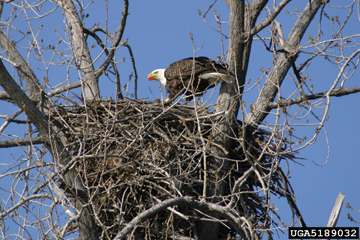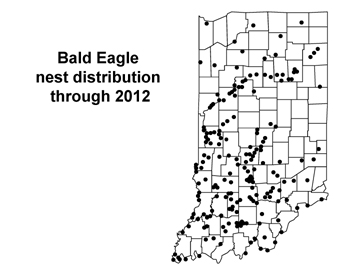Bald Eagles in Indiana
By John Castrale
The recovery of the Bald Eagle in North America and Indiana has been a remarkable success story. With fewer than 500 pairs counted in the lower 48 states during a survey during 1963, the population now exceeds 10,000 pairs in the same area. Steps critical to this rebound include the banning of DDT and other pesticides the 1970’s, protection under the Endangered Species Act and the Bald and Golden Eagle Protection Act, improved habitat conditions, and reintroduction projects in several states. Efforts by many governmental and private agencies and individuals have resulted in thriving numbers today and, as a result, the Bald Eagle was taken off the U.S. Endangered Species list in 2007 and Indiana’s list in 2008. It was once a rare event to encounter a Bald Eagle over much of the lower 48 states, but now Hoosiers have an excellent chance of seeing an eagle without driving very far during most times of the year.
The Wildlife Diversity Unit of the Indianan Division of Fish and Wildlife was instrumental in the recovery by obtaining and releasing Bald Eagles in south-central Indiana in the 1980’s. From 1985-1989, 73 eagles were transplanted from nests in Wisconsin and Alaska at 5-6 weeks of age and cared for at a facility at Lake Monroe. When the young birds were capable of flight at 10-12 weeks of age, they were released and provided food until they perfected their fishing skills. By the end of the fall, they had left the area with the expectation that when they reached maturity in 4-5 years, they would return to Indiana to establish breeding territories and nest. About a third of the released eagles survived and nested beginning in 1989, over 90 years after the last documented Indiana nesting record. Today that number has grown to over 150 nesting pairs and nests can be found in over half of Indiana’s 92 counties (Figure 1). Greatest concentrations are at the larger lakes and reservoirs such as Patoka and Monroe reservoirs and along larger rivers, especially the Wabash, White, and Ohio Rivers. Most nests are on private property, although public lands host a disproportionate number.
Bald Eagles can be encountered about anywhere in Indiana throughout the year, but they are most often found near larger bodies of water where they prey primarily on fish and water birds. Their feeding habits are diverse and they will feed on a variety of animals including road-killed birds and mammals and dead deer in fields. Nests are in larger, older trees usually near water, but can be over a mile away from water. Because the long wingspan of a Bald Eagle makes is difficult to navigate in thick vegetation, nests are generally near the shoreline or forest edge or opening, on a hillside slope, in an isolated tree or slightly above the surrounding forest canopy. Tree species most often used in Indiana include: eastern cottonwood, American sycamore, oaks, and eastern white pine. Most nest trees are living, although occasionally a dead snag is used. The large stick nests are placed near a major fork in the tree and more than one nest may be built in a territory. Because of the large size of the nests that are used for many consecutive years, nest trees may topple or branches supporting nests (6-10 feet in diameter) may be broken during wind and ice storms. Managing for Bald Eagles consists of encouraging or protecting large potential nest trees near water, minimizing disturbance near existing nest sites, and maintaining good water and wetlands that support healthy fish and water bird populations.
Although no longer governed under the Endangered Species Act, strong protection for Bald Eagles is still in place as a result of the Migratory Bird Treaty Act and especially the Bald and Golden Eagle Protection Act. In fact, the Bald Eagle has legal protection surpassing almost all other birds in the United States. Not only is it illegal to harm or disturb (even if actions are unintentional) an individual eagle without a permit, nests and areas around the nest tree are also protected. The U.S. Fish and Wildlife Service has published National Bald Eagle Management Guidelines, in part to benefit individuals from knowingly violating the law. These management guidelines prescribe distances between eagle nests and various man-made activities and may limit certain types of activities, especially during the nesting season which begins around February to March depending on geographic location. Although tree-cutting may be prohibited in the close vicinity of an eagle nest, timber harvesting is allowed at greater distances outside of the breeding season. A U.S. Fish and Wildlife biologist should be consulted about the specifics of these guidelines and permits can be obtained if activities cannot be avoided that may result in harm to a Bald Eagle.
John Castrale is a Nongame Bird Biologist with the Indiana Division of Fish and Wildlife. He has coordinated the restoration of bald eagles, peregrine falcons and osprey in Indiana.
